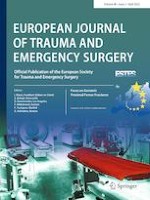Erschienen in:

11.04.2021 | Original Article
Impact of inflammatory cell ratio, biomarkers, activated partial thromboplastin time and prothrombin time on chronic subdural haematoma severity and outcome
verfasst von:
Olufemi Emmanuel Idowu, Stevens Olaide Oyeleke, Julius Mautin Vitowanu
Erschienen in:
European Journal of Trauma and Emergency Surgery
|
Ausgabe 2/2022
Einloggen, um Zugang zu erhalten
Abstract
Introduction
Chronic subdural haematoma (CSH) has multifactorial mechanisms involved in its development and progression. Identifying readily available inflammatory and coagulation indices that can predict the prognosis of CSH will help in clinical care, prognosis, generating objective criteria for assessing efficacy of treatment strategies and comparisons of treatment efficacy between clinical studies. We conducted a study in which we evaluated the impact value of neutrophil to lymphocyte ratio (NLR), platelet-to-lymphocyte ratio (PLR), inflammatory biomarkers (erythrocyte sedimentation rate and C-reactive protein), activated partial thromboplastin time (APTT), prothrombin time (PT) and international normalized ratio (INR) at presentation on CSH severity and outcome using Glasgow outcome scale (GOS), Markwalder grading scale (MGS) and Lagos brain disability examination scale (LABDES).
Methods
We prospectively studied patients in a single healthcare system with clinical and radiological features of chronic subdural haematoma. Only patients who were managed surgically were recruited. The primary outcome was predictors of severe form CSH (using admission Glasgow coma scale score, MGS grade, inflammatory cells and biomarkers, APTT, PT, and INR) and outcome (using GOS, MGS and LABDES grades 3 months) with secondary outcome being mortality rate, 3 months following surgery. Good outcome was defined as GOS score > 3, LABDES score ≥ 40 at three months and MGS score < 2. Differences in categorical and continuous variables between groups were compared using Fisher’s exact test or Chi-square test (χ2) analysis, one-way ANOVA or Kruskal–Wallis test (in case of non-normal distribution).
Results
We included 61 patients with a male-to-female ratio of 2.6:1 and mean age of 57.5 ± 13.3 years (median 58 years; 27–83 years). The pre-op MGS grade was significantly associated with the LABDES (
p = 0.034), GOS (
p = 0.011) and post-op MGS (
p = 0.007) grade. All the patients that died had elevated APTT and PT with low PLR. A low admission PLR was significantly associated with a poor outcome using the GOS (
p = 0.001), MGS (
p = 0.011) and LABDES grade (
p = 0.006) (Table
3). A high APTT was also significantly associated with a worse outcome using GOS (
p = 0.007), MGS (
p = 0.007) and LABDES grade (
p = 0.003). There were three (4.9%) deaths with post-mortem diagnosis of pulmonary embolism, chronic renal failure and irreversible craniocaudal herniation syndrome. All the patients that died had elevated APTT and PT with low PLR.
Conclusion
Patients’ admission APTT, PT, INR and PLR are good predictors of outcome using the GOS. A high admission INR is also associated with a worse outcome using MGS and LABDES grade.











